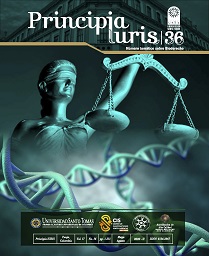Bioethical and biojuridical principlism: do european bioethics and biolaw need a different framework of principles?
Main Article Content
Abstract
Article Details
Por medio de esta comunicación certifico que el artículo que estoy presentando para posible publicación en la revista institucional impulsada de la Facultad de Derecho de la Universidad Santo Tomás seccional Tunja, Principia Iuris, es de mi entera autoría, siendo sus contenidos producto de mi directa contribución intelectual.
Todos los datos y referencias a publicaciones hechas están debidamente identificados con su respectiva nota bibliográfica y en las citas que se destacan como tal.
Por todo lo anterior, declaro que el material presentado se encuentra conforme a la legislación aplicable en materia de propiedad intelectual, y por lo tanto, me hago responsable de cualquier reclamación relacionada a esta.
En caso de que el artículo presentado sea publicado, manifiesto que cedo plenamente a la Universidad Santo Tomás seccional Tunja los derechos de reproducción del mismo y accedo a las modificaciones que de forma se requieran para adaptarse a la estética de la revista. Como contraprestación de la presente cesión, declaro mi conformidad de recibir (2) ejemplares del número de la revista en que aparezca mi artículo.
References
Beauchamp, T.L. (2011). Making Principlism Practica!: A Commentary on Gordon, Rauprich, and Vollmann. Bioethics, 25, 301- 303.
Braybrooke, D. (1972). Toe Firrn but Untidy Correlativity of Rights and Obligations. Canadian Journal of Philosophy, 1, 351-63.
Clouser, D. & and Gert, B. (1990). A Critique of Principlism. Journal of Medicine and Philosophy, 15, 219-236.
Council ofEurope (2003). Convention for the Protection of Human Rights and Fundamental Freedom. http://sutyajnik.ru/rus/echr/echr_ eng.pdf. Accessed 12 December 2014.
Daniels, N. (1996). Wide Reflective Equilibrium in Practice. In L.W Sumner & J. Boyle, Philosophical Perspectives on Bioethics (pp. 96-114). Toronto: University ofToronto Press.
Daniels, N. (1979). Wide Reflective Equilibrium and Theory Acceptance in Ethics. Journal of Philosophy, 76, 256-82.
DeGrazia, D. & Beauchamp, T.L. (2001). Philosophical Foundations and Philosophical Methods. In D. Sulmasy & J. Sugarman (Eds.), Methods of Bioethics (pp. 33-36). Washington: Georgetown University Press.
Dickenson, D.L. (1999). Cross-Cultural Issues in European Bioethics.
Bioethics, 13, 249-55.
Donagan, A. (1977). Toe Theory of Morality. Chicago: University of Chicago Press.
Feinberg, J. (1984). Toe Moral Limits of the Criminal Law. New York: Oxford University Press.
Feinberg, J. (1980). Rights, Justice, and the Bounds of Liberty.
Princeton, N.J.: Princeton University Press.
Griffin, J. (2008). On Human Rights. Oxford: Oxford University Press.
Gert, B. (2007). Common Morality: Deciding What to Do. New York: Oxford University Press.
Gert, B., Culver, CH., & Clouser, D. (2006). Bioethics: A Systematic Approach. New York: Oxford University Press.
Gert, B. (2005). Morality: Its Nature and Justification, 2nd Rev. Ed.
New York: Oxford University Pres.
Gordon, J.S., Rauprich, O., & Vollman, J. (2011). Applying the Four Principle Approach. Bioethics, 25, 293-300.
Hart, H.L.A. (1973). Bentham on Legal Rights. In A.W.B Simpson (Ed.), Oxford Essays in Jurisprudence. Oxford: Clarendon Press.
Holm, S. (1994). Not Just Autonomy-The Principles of American Biomedical Ethics. Journal of Medical Ethics, 21, 332-338.
Kukla, R. (2014). Living with Pirates. Cambridge Quarterly of Healthcare Eth ics, 23, 75-85.
Lawson, R. (2007). Harmonising Human Rights in Europe. In J. Gunning & S. Holm (Eds.), Ethics, Law, and Society. Aldershot: Ashgate Publishing.
Lindsay, R.A. (2005). Slaves, Embryos, and Nonhuman Animals: Moral Status and the Limitations of Common
Morality Theory. Kennedy Institute of Ethics Journal, 15, 323-46.
Lyons, D. (1970). The Correlativity of Rights and Duties. Nous, 4, 45-55.
Miers, S. (2003). Slavery in the Twentieth Century: The Evolution of a Global Problem. Walnut Creek, CA: AltaMira Press.
Pellegrino, E. & Thomasma, D. (1988). For the Patient's Good: The Restoration of Beneficence in Health Care. New York: Oxford University Press.
Pellegrino, E. (1994). The Four Principles and the Doctor-Patient Relationship: The Need For A Better Linkage. In R. Gillon (Ed.), Principles of Health Care Ethics (pp. 353-367). Chichester: John Wiley & Sons.
Rauprich, O. (2013). Principlism. International Encyclopedia of Ethics. Wylie Online Library. http://onlinelibrary.wiley.com/ doi/10.1002/978l 444367072.wbiee658/abstract . Accesed 20 February 2015.
Rauprich, O. (2008). Common Morality: Comment on Beauchamp and Childress. Theoretical Medicine and Bioethics, 29, 43-71.
Rawls, J. (1971). A Theory of Justice. Cambridge MA: Harvard University Press.
Rendtorff, J.D. (2002) . Basic Ethical Principles in European Bioethics and Biolaw: Autonomy, Dignity, Integrity, and Vulnerability-Towards a Foundation of Bioethics and Biolaw. Medicine, Health Care, and Philosophy, 5, 235-44.
Rendtorff, J.D. & Kemp, P. (2000). Basic Ethical Principles in European Bioethics and Biolaw, Vols. 1-2.
Copenhagen and Barcelona: Centre for Ethics and Law & Institut Borja de Bioetica.
Rendtorff, J.D. (2000). The Second International Conference about Bioethics and Biolaw: European Principles in
Bioethics and Biolaw:' In P. Kemp, P., J.D. Rendtorff & N.M. Johansen (Eds.), Bioethics and Biolaw: Four Ethical Principles Vol. 2. (pp. 155-171), Copenhagen: Rhodos.
Richardson, H.S. (2000). Specifying, Balancing, and Interpreting Bioethical Principles. Journal of Medicine and Philosophy, 25, 285-307.
Richardson, H.S. (1990). Specifying Norms as a Way to Resolve Concrete Ethical Problems. Philosophy and Public Affairs, 19, 279-310.
Ross, WD. (1939). Toe Foundations of Ethics. Oxford: Oxford University Press.
Sen, A. (1997). Human Rights and Asian Values. New York: Carnegie Council on Ethics and International Affairs.
Sen, A. (1997). Resources, Values and Development. Cambridge, MA: Harvard University Press.
Strong, C. (2000). Specified Principlism. Journal of Medicine and Philosophy, 25, 285-307.
United Nations Commissioner for Human Rights (1991). Fact Sheet No.14, "Contemporary Forms of SlaverY:' http://www.unhchr.ch/html/ menu6/2/fs14.htm . Accessed 5 February 2015.
Valdés, E. (2019). Towards a New Conception ofBiolaw. In Valdés, E. & Lecaros, J.A. Biolaw and Policy in the Twenty First Century: Building Answers for New Questions. Switzerland: Springer.
Wallace, K.A. (2009). Common Morality and Moral Reform. Theoretical Medicine and Bioethics, 30, 55-68.
Wellman, C. P. (1995). Real Rights. New York: Oxford University Press.

